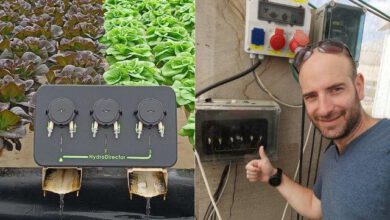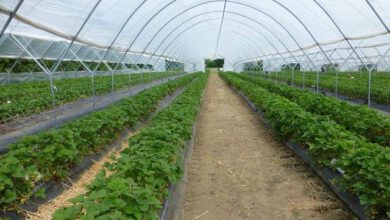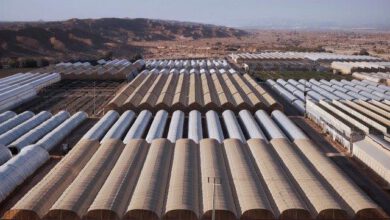Using Photoselective Shade Netting for Improving Sweet Pepper Productivity
Colored shade nets developed to filter selected regions of the spectrum of sunlight, concomitantly with inducing light scattering
E. Fallik et al.
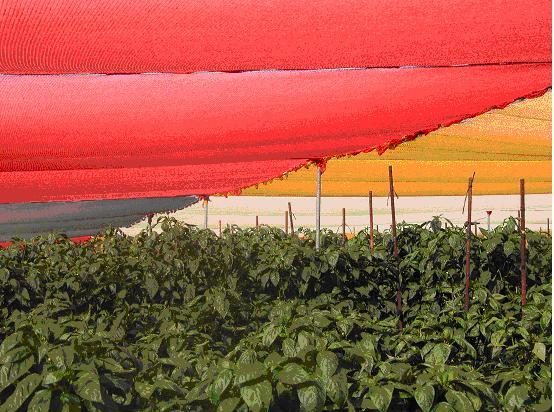
In recent years, numerous crops have been found to improve their productivity and fruit quality when grown under colored (photo-selective) shade nets (ChromatiNets™, Polysack Plasic Industries, Nir-Yitzhak-Sufa, Israel) (Shahak, 2008b; Shahak et al., 2004). The colored shade nets have been developed during the past decade to filter selected regions of the spectrum of sunlight, concomitantly with inducing light scattering. They are designed specifically to modify the incident radiation (spectrum, scattering and thermal components). Depending on the pigmentation of the plastic threads and the knitting design, these nets provide varying mixtures of natural, unmodified light, together with spectrally modified scattered light. They are aimed at optimizing desirable physiological responses, in addition to providing physical protection to the crop (Shahak, 2008; Shahak et al. 2008b).
In 2008, red pepper (Capsicum annuum L.) cultivars, cv. ‘Vergasa’ and cv. ‘Romans’ were grown at the B’sor Experimental Station in south-west Israel, using commercial cultivation practices, under four different colored shade-nets, as follows: pearl, red, yellow, black with 35% relative shading (in PAR) (Polysack Plastics Industries). Fruit was harvested weekly, at a stage of maturity of 80-85% red, using a sharp clipper, without the calyx. The cumulative total and export-quality fruit yield were evaluated from the beginning of September until the beginning of December. Export-quality fruit was designated as fruit above 130 g each (medium size and above), without blemishes or defects.
The influence of colored shade nets on postharvest quality was evaluated four times during the growing season for export-quality fruit. The fruit quality parameter of decay incidence, was evaluated immediately after each harvest, and at the end of 14 days of storage at 7°C and a relative humidity (RH) of ~94%, plus 3 days at 20°C.
Field yield and export-quality yield
The results showed a significant increase in the total fruit yield under the photo-selective shading. In cv. Vergasa, the red, yellow and pearl shade nets increased the yield by 30, 32 and 34%, respectively, relative to the commercial black shade net (Fig. 1A), while in cv. Romans, the red, yellow and pearl nets increased the yield by 6, 16 and 14%, respectively, compared with the commercial black shade net (Fig. 1B). The export-quality yield was affected to a larger extent. In this case the relative increase by the red, yellow and pearl was 39, 56 and 56%, respectively, in cv. Vergasa (Fig. 1A), and in cv. Romans, the export-quality yield increased by 2, 34 and 18%, under the red, yellow and pearl shade net, respectively.
Postharvest quality
In preliminary experiments conducted in 2007, results have shown that fruit harvested from yellow and red colored shade nets had significant less decay incidence after prolonged storage (Fallik et al., 2009). In 2008, after 14 days of storage at 7°C plus 3 days at 20°C, the decay incidence was affected significantly by the shade nets (Fig. 2). At the end of storability and shelf-life simulation, fruit grown and harvested under the pearl shade net, had a significantly lower decay incidence compared with fruit harvested under the commercial black shade net. Fruit harvested under yellow shade nets also had a relatively low decay incidence compared with the commercial black shade net. The main decay-causing-agent isolated from decayed pericarp and calyx was Botrytis cinerea. No significant differences were found in fruit firmness or sugar content, as evaluated by total soluble solids under the different shade nets.
CONCLUSIONS
We have demonstrated here the potential use of pearl and yellow colored shade nets to improve pepper productivity, relative to the traditional black shade nets, and to maintain better fruit quality after prolonged storage and shelf-life. The more pronounced effect on the export-quality yield, especially by the yellow and pearl nets, is probably related to the reduction of aphid-borne viral disease by the yellow and pearl nets (Shahak et al. 2008a). The significantly lower decay incidence at the end of storability and shelf-life simulation is a most interesting result. How does the stored fruit “remember” its light conditions during growth? There are a few alternative explanations for the effects of light-quality during plant growth, which, at this stage, are all hypothetical: (i). The quality of light might directly affect the pathogen propagation in the field, to be later expressed during post-harvest; (ii) photoselective effects on fruit traits related to the infectibility of the fungal pathogen, such as sink, or cuticle morphology, or defense processes; (iii) an indirect photoselective effect on the plant host susceptibility, which will affect storability and shelf-life.
More research is required for establishing the results, understanding the physiological mechanisms behind the plant and fruit responses (pre- and postharvest), and implementing the results in a wider range of crops and environmental conditions.
Acknowledgement
These results are part of Mr. Aviv Goren’s master thesis in the department of Postharvest Science of Fresh Produce in Volcani Center.
References
Fallik. E., Alakali-Tuvia, S., Parselan, Y., Aharon, Z., Offir, Y., Matan, E., Yehezkel, H., Ratner, K., Zur, N. and Shahak, Y. 2009. Can colored shade nets maintain sweet pepper quality during storage and marketing? Acta Hort. 830: 37-43.
Shahak. Y. 2008. Photo-selective netting for improved performance of horticultural crops. A review of ornamental and vegetable studies carried out in Israel. Acta Hort. 770: 161-168.
Shahak, Y., Gal, E., Offir, Y. and Ben-Yakir, D. 2008a. Photoselective shade netting integrated with greenhouse technologies for improved performance of vegetable and ornamental crops. Acta Hort. 797: 75-80.
Shahak, Y., Gussakovsky, E.E., Gal, E. and Ganelevin, R. 2004. ColorNets: Crop protection and light-quality manipulation in one technology. Acta Hort. 659:143-151.
Shahak, Y., Ratner, K., Giller, Y.E., Zur, N., Or, E., Gussakovsky, E.E., Stern, R., Sarig, P., Raban, E., Harcavi, E., Doron, I. and Grenblat-Avron, Y. 2008b. Improving solar energy utilization, productivity and fruit quality in orchards and vineyards by photoselective netting. Acta Hort. 772: 65-72.
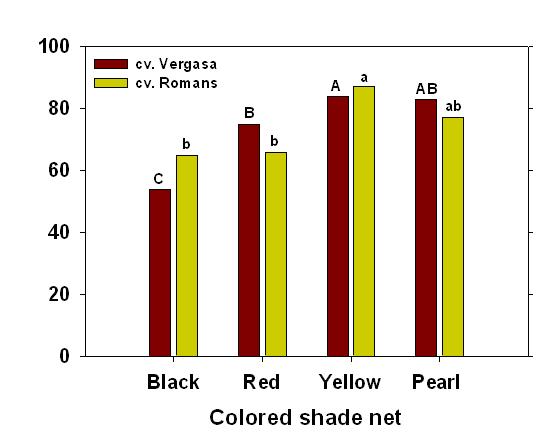
Figure 1: The influence of different colored shade nets on the total fruit yield and the export-quality fruit yield, in tons per hectare of red pepper cv. Vergasa (A) and Romans (B). Means with different upper-case letters are significantly different for total yield, while means with different lower-case letters are significantly different for export-quality yield (P = 0.05).
.jpg)
Figure 2: The influence of different colored shade nets on decay incidence in red pepper cultivars; cv. Romans and cv. Vergasa, after 14 days at 7°C + 3 days at 20°C. Means of 4 harvests from September to December. Means with different upper-case letters are significantly different for cv. Romans, while means with different lower-case letters are significantly different for cv. Vergasa (P = 0.05).
Picture 1: Pepper plants after 6 weeks

Picture 2: Pepper plants after 4 months

Authors:
Elazar Fallik1*, Aviv Goren1, Sharon Alakali-Tuvia1, Yaacov Parselan1, Zion Aharon1, Kira Ratner2, Naftali Zur2, Hanna Yehezkel3, and Yosepha Shahak2
1Department of Postharvest Science of Fresh produce; 2Department of Fruit Tree Sciences, ARO – The Volcani Center, Bet-Dagan, Israel; 3Besor Experimental Station, Negev, Israel
(Published in ISRAEL AGRICULTURE, 2010)

